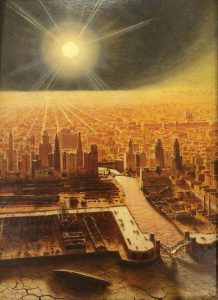Shinichi Hoshi’s 1963 short story “Bokko-Chan” and Sakyo Komatsu’s 1967 “Take Your Choice,” written by Japanese authors only four years apart, construct remarkably similar narratives. Both stories are exclusively populated by men, who, motivated by greed and lust, make choices that eventually backfire, hurting themselves and everyone around them. The scammers in the two stories weaponize the science fictional tools of robots and time travel for profit. When the schemes go wrong, everyone is to blame: the bar-master who built a robot to make money, the men who believe she is a real woman, the scammers who make a fortune selling fake time travel worldwide, the people who choose the nuclear future. “Bokko-Chan” and “Take Your Choice” encourage wariness of science fiction and explore the consequences of deceit, greed, and lust in post-occupation Japan.
Both “Bokko-Chan” and “Take Your Choice” feature nameless male proprietors who construct schemes to scam nameless male customers. Throughout the story, Bokko-chan’s owner is called “the bar-master” (Hoshi, p. 48) by the omniscient narrator, and the only other characters mentioned are “a young man” (Hoshi, p. 50), also referred to as “the youth” and “the boy” (Hoshi, p. 51), and “his father” (Hoshi, p. 50). The protagonist of “Take Your Choice,” solely referred to as “he,” uses “the elderly proprietor” (Komatsu, p. 86) and “the little man” (Komatsu, p. 88) to describe the scammers. The anonymity of the characters in both stories suggests that anyone could take on the role of scammer or scammed and implicates the (male) reader in the resulting disasters. The only name in either story is given to Bokko-chan, who is also the only female. Despite having a name, Bokko-chan is a device rather than a character: her lack of agency is clear throughout the story as she converses by repeating what patrons say to her without comprehension and is little more than a bar tap to the proprietor. Both “Take Your Choice” and “Bokko-Chan” depict men as the scammers and choosers of the world; their creations and decisions affect the future, while the sole woman is merely a tool of this process, comparable to the films and doors of “Take Your Choice.”
In both stories, the scammers exploit lust and desire, using science fictional devices to deceive their customers for profits. The scam in “Bokko-Chan” revolves around the science fictional element of a female robot, unsophisticated “since the designing of a complex brain was beyond the capabilities of her inventor” (Hoshi, p. 48) but “able to answer questions of the simplest form and perform simple motions” (Hoshi, p. 48) and with a spout from which the bar-master drains and reuses the drinks men buy her. Komatsu explains the mechanics of the much more complex “Take Your Choice” scam in detail, emphasizing the reliance on science fiction elements: “time-space channel … using only ordinary doors of no special value and shop-worn SF films … make them faint once in the next small room with an anesthetic gas and a vibrating device, and when they come out through the very same door, we make sure they think they’re in another world” (Komatsu, p. 102). Bokko-chan’s gullible admirers find her “charming, young, prissy and smart to chat with” (Hoshi, p. 49), an ideal woman. Thus, the bar-master harnesses lust to increase his profits: Bokko-chan attracts more customers, and when they buy drinks for her, “being a frugal man, he would serve them again to the customer” (Hoshi, p. 50). Similarly, desire motivates patrons in “Take Your Choice” to choose the third door: “people are, in one way or another, very lewd. Can’t help having a wish to peep. To satisfy this secret lustful desire for peeping, they don’t care if the world is blown up” (Komatsu, p. 103). “Making a fortune” (Komatsu, p. 102) is the objective of this scam, too, as the proprietors charge “two million five hundred thousand credits” (Komatsu, p. 89) per customer and have served thousands. While the scams operate on vastly different scales – one bar versus the whole world – both are motivated by greed, harness lust, and rely on science fictional devices.
In the end, everyone suffers from the scams in “Bokko-Chan” and “Take Your Choice”: patrons, perpetrators, and bystanders. In “Bokko-Chan,” the bar-master and the patrons die after drinking the poisoned liquor that the young man gave Bokko-chan. The bar-master’s practice of re-serving the drinks which admirers buy for Bokko-chan backfires, and everyone suffers from his deceit. The young man who drugs Bokko-chan’s drink runs away after doing so and thus evades death, but he is still hurt by the scam, spending all of his money to impress Bokko-chan and getting caught stealing from his father. At the end of “Take Your Choice,” the scammers realize that since thousands of people with influence choose the future of a nuclear holocaust, it will likely come to pass, killing everyone in the world. Interestingly, the deaths in both stories are only implied. Once the bar-master in “Bokko-Chan” serves the poisoned drinks, “nobody departed and yet nobody spoke” (Hoshi, p. 51) – it is clear that the bar-master and the patrons have all died, but it is not stated directly. “Take Your Choice” concludes with the realization that “if the people who believe that this world will definitely be finished in little more than a decade are going to increase in large numbers all over the world…? You know, among our customers there were many officials, officers, politicians…” (Komatsu, p. 103). Once again, the meaning is clear, but the eventual negative outcome is only implied through the ellipses. Rather than preaching and moralizing, Hoshi and Komatsu encourage the reader to realize the consequences on their own.
“Bokko-Chan” and “Take Your Choice” condemn both deceit and gullibility, and the deadly consequences of greed, lust, and science fiction suggest fears of modernization and Westernization in post-occupation Japan. The two stories include other Japanese concerns as well. The “strong desire for destruction” (Komatsu, p. 103) discussed in “Take Your Choice” – “though they may speak of peace and humanism when they open their mouths, in their minds – consciously or otherwise – they all want to witness the end of the world” (Komatsu, p. 103) – is reminiscent of the American bombing of Hiroshima and Nagasaki. Bokko-chan, the “charming robotess” (Hoshi, p. 48) who is admired for echoing what men tell her rather than having thoughts of her own could indicate fears and frustrations with increasingly independent women. Through dangerous scams that seem profitable until they backfire, “Bokko-Chan” and “Take Your Choice” demonstrate a deep mistrust of a too-rapidly changing world.
Works Cited
Hoshi, Shinichi. “Bokko-Chan” (1963). Trans. Noriyoshi Saito. The Best Japanese Science Fiction Stories, Ed. John L. Apostolou and Martin Harry Greenberg. New York: Dembner Books, 1989. 47-51.
Komatsu, Sakyo. “Take Your Choice” (1967). Trans. Shiro Tamura and Grania Davis. The Best Japanese Science Fiction Stories, Ed. John L. Apostolou and Martin Harry Greenberg. New York: Dembner Books, 1989. 85-103.











 From the about page: “My initial goal with Sunbeam was to create a version of outer space that I would want to live in. So of course that includes tons of queer people, no men (did you notice?), trees, old buildings, and endless constellations.”
From the about page: “My initial goal with Sunbeam was to create a version of outer space that I would want to live in. So of course that includes tons of queer people, no men (did you notice?), trees, old buildings, and endless constellations.”